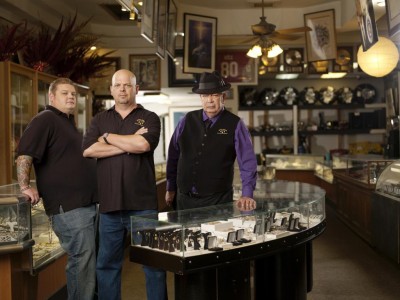| Reviews & Columns |
|
Reviews DVD TV on DVD Blu-ray 4K UHD International DVDs In Theaters Reviews by Studio Video Games Features Collector Series DVDs Easter Egg Database Interviews DVD Talk Radio Feature Articles Columns Anime Talk DVD Savant Horror DVDs The M.O.D. Squad Art House HD Talk Silent DVD
|
DVD Talk Forum |
|
|
| Resources |
|
DVD Price Search Customer Service #'s RCE Info Links |
|
Columns
|
|
|
Pawn Stars - Volume 5
Very little needs to be said. Where Volume Four included the last ten episodes of season three and the first six of season four, Pawn Stars - Volume Five offers 16 more shows, all from the middle of season four (2011). (The packaging insists they're from seasons three and four, but Wikipedia and other episode guides disagree.) Seasons four and five were expanded considerably, to 54 and 56 episodes, respectively, about double the output of the early seasons, so breaking them into volume rather than season sets makes sense, I suppose.
As before, aesthetically Pawn Stars changes not in the slightest. The program follows the appraising and haggling of rare and oddball items at the Gold & Silver Pawn Shop in Las Vegas, and whose TV fame clearly is attracting a higher caliber of collectible items. The shop is co-owned by Rick Harrison (who resembles Michael Chiklis) and his cantankerous, self-consciously colorful father, Richard ("the Old Man"). Together they're grooming Rick's son, Corey (also known as "Big Hoss"), to eventually run the store. But he and Corey's dim-witted pal Chumlee (even more self-consciously colorful than The Old Man) often get into trouble, buying expensive items without proper authorization.
The DVD, distributed by New Video, is properly presented in 16:9 enhanced widescreen, but has no extra features.
I don't have much to add about the show that I didn't already say in my reviews of season two, volume three, and volume four though I've included a few notes about this specific set below.
If you're thinking about selling a family heirloom, Pawn Stars is a good primer to learn a thing or two about the art of haggling. For instance, the seller is in a much better position to negotiate if he's done his research beforehand, finding similar items on the Internet and having some idea of just what it is he's trying to sell. Paperwork documenting the item's history is also useful. And, if you watch the show enough, it's pretty obvious what to reasonably expect.
If the various pawnbrokers actually want to buy your item, their usual first offer is between 40-45% of what they think they can sell it for. Too often sellers are told by the program's independent experts - "Let me call a buddy of mine who's an expert in this sort of stuff," Rick'll say - that an item is worth, say, between $3,000 and $5,000. When Rick then asks, "So, how much were you looking to get out of this item?" the seller almost invariably knee-jerk responds with, "$5,000!" Cut to Rick rolling his eyes or replying with a deadpan, "Ah, no."
What it boils down to are factors like the size of the item (too big or too vast and it becomes more trouble than it's worth; big items take up too much room while vast collections of toys and comic books are avoided because of the man-hours tied up trying to catalog everything), how quickly it can be sold, and the market for that particular item. (George Washington? Hot. Baseball cards? Ice cold.) Oftentimes customers will bring in something utterly fascinating but also too unique, so uncategorical that, neat as it is, there's just no market. To his credit, Rick is understandably leery of things like Nazi memorabilia, torture devices, and certain kinds of weapons, even though these items would probably sell.
If the shop does want to buy your item, that narrow range of 40-45% is about all one can reasonably expect. When a customer brings in something truly outstanding, Rick will go higher than 50%, up to around 75%, particularly if the item's value is pretty rock solid, like gold items, or if it's something he knows he can turn around and sell immediately.
It's also interesting watching the very different haggling tactics of Rick, Richard, and Corey. The Old Man uses his intimidating, imposing and poker-faced presence in an Old School haggler way that contrasts Rick and Corey. If the Old Man offers $100 for something and the customer counters with $150, the Old Man is apt to reply, "How about $50?"
Rick, on the other hand, grins like the Cheshire Cat and snickers just like this character to ease negotiations through awkward moments, and is always extremely polite even with customers trying to unload worthless junk ("But, gee - thanks for bringing this in to show me. It's really neat.") Corey, less experienced and neither as intimidating as the Old Man nor as smooth and sociable as his father, knows the numbers he has to work with (usually) but lacks their confidence. Rarely, for instance, does he look his customers in the eyes during critical bargaining moments.
In Volume Five, the appeal of the series is immediately apparent. Items featured in these episodes are almost always totally fascinating, and while the show's structure misleadingly suggests Rick and the others are casually knowledgeable about absolutely everything, from 13th century swords to rare coins to car-crushing Robosauruses, the historical value of many items, from real pieces of American and world history that ought to be in museums, to pop culture and Americana items from the last century, and the personal stories behind their acquisitions are consistently mesmerizing.
Volume Five includes such things as a book once owned by Sir Isaac Newton; a collection of John Wayne memorabilia; an unopened, half-century-old can of fallout shelter survival crackers; a Breitling emergency watch; a 1907 Gibson mandolin possibly worth $150,000; a sealed box of Cuban cigars dating back to the 1940s; a 1937 Little Orphan Annie decoder pin (as seen in A Christmas Story); a Batmobile replica; an engraving signed by Thomas Jefferson and James Madison; and lots, lots more.
The episodes I watched do seem to be dialing back a bit on the obviously half-scripted/half-improvised scenes of domestic comedy, peculiarly recasting Rick as an Edgar Kennedy-like hothead, his slow burn always ready to lash out at Corey's occasional and Chumlee's frequent foolishness. It's very artificial and doesn't really serve the show well.
Video & Audio
Pawn Stars - Volume Five is presented in 1.78:1 widescreen with 16:9 enhancement, in a transfer up to contemporary television standards, as is its 2.0 Dolby Stereo. This release includes subtitle options in both English and Spanish. The set is composed of sixteen 22-minute episodes on two single-sided, dual-layered discs. No Extra Features.
Parting Thoughts
As always, Pawn Stars is a genuinely fun and fascinating show, and Highly Recommended.
Stuart Galbraith IV is a Kyoto-based film historian whose work includes film history books, DVD and Blu-ray audio commentaries and special features. Visit Stuart's Cine Blogarama here.
|
| Popular Reviews |
| Sponsored Links |
|
|
| Sponsored Links |
|
|
| Release List | Reviews | Shop | Newsletter | Forum | DVD Giveaways | Blu-Ray | Advertise |
|
Copyright 2024 DVDTalk.com All Rights Reserved. Legal Info, Privacy Policy, Terms of Use,
Manage Preferences,
Your Privacy Choices | |||||||














